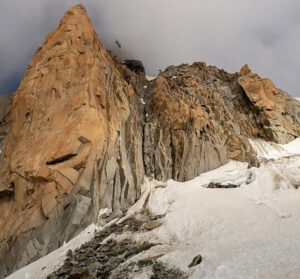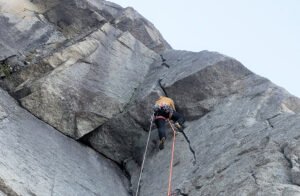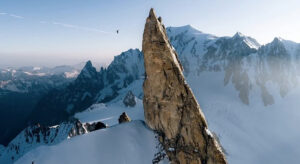Is this the beginning of the end of European alpinism?
The problems in the Alps began in early July when a serac fell on Marmolada peak in Italy, killing 11. Then guides refused to venture up the Matterhorn and other of Europe’s most popular peaks. Numerous smaller accidents, many more than usual, have stretched rescue crews thin.
This week, two of Mont Blanc’s most popular refuges closed to deter climbers who insisted on ignoring the warnings. It is clear that some of the most visited mountains in the world are reeling from climate change.
“I have witnessed the deterioration of glaciers since the 1980s,” IFMGA guide and 14×8,000m summiter Ferran Latorre told ExplorersWeb. “But this year, nature took a leap forward. The really scary thing is that this is not going to improve in the future.”

IFMGA guide Ferran Latorre atop the Matterhorn earlier this summer. Photo: David Pujol
The popularity problem
The Alps’ popularity is part of the problem. High numbers increase all statistics, including the bad ones. For instance, 500 people have died on Matterhorn since the tally began in the mid-1800s. By contrast, slightly over 300 climbers have died on Everest since Mallory and Irvine.
The figure is even greater on Mont Blanc, with an estimated 1,400 dead. But one must bear in mind that its slopes see thousands of climbers, most of them in summer. Mont Blanc has everything to draw crowds: an alluring altitude (it is the roof of Western Europe), great scenery, a rich history of mountaineering, and a technically easy normal route.
Apart from the deaths, the number of injured or sick climbers needing rescue is now astronomical. Even during an average season, rescuers work at capacity. But 2022 is not average. The extraordinarily high temperatures and dryness have vastly exacerbated ordinary summer perils. Glaciers lack snow, and frozen ground thaws, sending rocks and ice chunks cannonballing downhill. Sometimes, whole slopes give way.
At the same time, the number of visitors has boomed after two years of pandemic restrictions. Many of them are not prepared or even aware of the dangers that mountains pose.

Climbers on Mont Blanc. Photo: Adventure Base
In the Swiss Alps, 3,680 people needed assistance in 2021 — 20% more than the previous year, reports Swissinfo. Most of the injured are not climbing highly difficult routes. They are hikers and cyclists.

Statistics compiled by Swissinfo show that falls are the major cause of accidents in the Bavarian Alps.
In the lower Bavarian Alps, 30 people have died during the first six months of 2022. Previously, that was typically the final figure for the entire year.
“Tourists go on mountain routes that do not correspond to their capabilities and ‘blind trust’ in mobile applications,” lamented Joachim Herrmann of the German Ministry of Domestic Affairs last week.
Recently, Jean-Marc Peillex, the mayor of the French mountain town of Saint Gervais, passionately denounced “pseudo-alpinists” who “play Russian roulette” on Mont Blanc. Exasperated, he finally decided to close the Goûter and Tête Rousse refuges on the peak’s normal route until further notice.
The video below shows Italian rescuers airlifting an injured climber from Pollux Peak, in the Aosta valley — just one of many rescues in the Alps this summer.
The guide’s take: Ferran Latorre
The future is not bright for mountain professionals.
“Conditions this year are the hardest I have ever experienced in all my years of guiding in the Alps,” Ferran Latorre told ExplorersWeb. “Yes, we saw the changes coming, but the transformation has become obvious now, and it is nightmarish.”

Ferran Latorre in the Alps. Photo: Ferran Latorre
Like many professional guides in Europe, Latorre started his season in Chamonix but had to move elsewhere as conditions on Mont Blanc deteriorated. Now, he is mainly guiding clients up Gran Paradiso and Monte Rosa.
Latorre began as a high-level rock climber and alpinist. Many of the routes he used to climb in the Mont Blanc massif in the 1980s simply do not exist anymore or are undoable in summer.
“I had never seen the glaciers so dry, so heavily crevassed. But the real worry is the instability that thawing permafrost creates. What we all considered sound terrain is not safe anymore. The entire structure of the mountains is crumbling!”

Several clients who booked guided climbs of the Matterhorn and Mont Blanc are being advised to switch to Monte Rosa, above, which is still open. Photo: Roger Lopez de Aro
The beginning of the end of alpinism?
“Apparently easy areas have become objectively dangerous and completely unpredictable,” Latorre explained. “You may take precautions on a glacier, but you cannot tell when a whole slope is going to crumble down.”
Veteran guides share news when they meet in the mountain huts. One of them recently told Latorre that out of the 100 Finest Routes in the Mont Blanc massif, listed by Gaston Rebuffat in his classic reference book, many are not possible anymore. Either the ice is gone, the rock is too unstable, or the approaches are too difficult.
“This is only going to get worse,” said Latorre. “At this rate, I do not know what will be climbable in the future in the Alps and other mountain ranges.”






